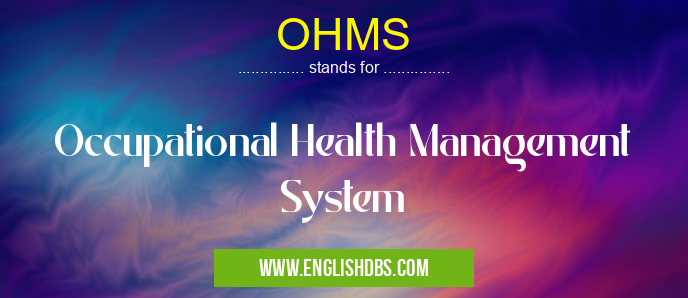What does OHMS mean in HEALTHCARE
An Occupational Health Management System (OHMS) is a comprehensive set of policies, procedures, and practices that an organization implements to protect and promote the health and well-being of its employees. An OHMS helps organizations to identify, assess, and control occupational hazards, and to provide employees with the necessary information, training, and resources to work safely and healthily.

OHMS meaning in Healthcare in Medical
OHMS mostly used in an acronym Healthcare in Category Medical that means Occupational Health Management System
Shorthand: OHMS,
Full Form: Occupational Health Management System
For more information of "Occupational Health Management System", see the section below.
» Medical » Healthcare
Key Components of an OHMS
An OHMS typically includes the following key components:
- Hazard identification and risk assessment: The process of identifying and assessing potential hazards in the workplace, and determining the associated risks.
- Hazard control: The implementation of measures to eliminate or control hazards, and to reduce the associated risks.
- Employee health and safety training: The provision of training to employees on occupational health and safety hazards, risks, and controls.
- Employee health surveillance: The monitoring of employees' health to identify and prevent occupational illnesses and injuries.
- Emergency preparedness and response: The development and implementation of plans and procedures to respond to occupational emergencies.
- Recordkeeping and documentation: The maintenance of records and documentation related to occupational health and safety.
Benefits of an OHMS
Implementing an OHMS can provide numerous benefits for an organization, including:
- Improved employee health and well-being: An OHMS helps to protect employees from occupational hazards and to promote their health and well-being.
- Reduced absenteeism and presenteeism: An OHMS can help to reduce absenteeism and presenteeism by preventing occupational illnesses and injuries.
- Increased productivity: A healthy and safe workforce is more productive and efficient.
- Reduced costs: An OHMS can help to reduce costs associated with occupational illnesses and injuries, such as workers' compensation claims and lost productivity.
- Improved compliance: An OHMS can help organizations to comply with occupational health and safety regulations.
Essential Questions and Answers on Occupational Health Management System in "MEDICAL»HEALTHCARE"
What is an Occupational Health Management System (OHMS)?
An OHMS is a comprehensive framework designed to protect and promote the health and well-being of employees while ensuring compliance with occupational health and safety regulations.
Why is an OHMS important?
An effective OHMS provides numerous benefits, including improved employee health and safety, reduced absenteeism and presenteeism, enhanced productivity, and improved compliance with legal requirements.
What are the key components of an OHMS?
Essential components include risk assessment, health surveillance, health promotion, emergency preparedness, and health information management.
How does an OHMS contribute to employee well-being?
By identifying and mitigating workplace hazards, providing health and wellness programs, and supporting employees with health concerns, an OHMS fosters a positive and healthy work environment.
How does an OHMS improve productivity?
A healthy and engaged workforce experiences less absenteeism and presenteeism, resulting in increased productivity and reduced costs associated with employee turnover and disability.
What are the legal considerations for an OHMS?
OHMSs must comply with all applicable occupational health and safety regulations, including those related to hazard identification, risk assessment, and employee training.
How can I implement an OHMS?
Implementing an OHMS typically involves conducting a needs assessment, establishing a management team, developing policies and procedures, and training employees on the system.
What are the challenges in implementing an OHMS?
Challenges may include securing management buy-in, obtaining necessary resources, ensuring employee engagement, and continuously monitoring and evaluating the system.
How can I measure the effectiveness of my OHMS?
Key metrics for measuring effectiveness include employee health and safety outcomes, compliance with regulations, and employee satisfaction.
Are there resources available to support OHMS implementation?
Yes, many organizations, such as the Occupational Safety and Health Administration (OSHA) and the National Institute for Occupational Safety and Health (NIOSH), provide resources, guidance, and training materials.
Final Words: An OHMS is an essential tool for organizations that want to protect and promote the health and well-being of their employees. By implementing an OHMS, organizations can create a safe and healthy workplace, reduce costs, improve productivity, and comply with regulations.
